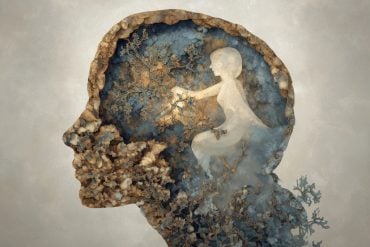Summary: Researchers provide new insights into the brain mechanisms behind psychosis. The research identified malfunctions in two critical brain systems—the “filter” and the “predictor” in individuals with psychosis.
These systems, which help direct attention and anticipate rewards, become impaired, leading to symptoms such as hallucinations and delusions. By studying young individuals with 22q11.2 deletion syndrome—a condition with a high risk of psychosis—the researchers offer a clearer picture of how these dysfunctions occur, potentially guiding future treatments and prevention strategies.
Key Facts:
- The study focuses on individuals with 22q11.2 deletion syndrome, linking their brain patterns to common psychosis symptoms.
- It reveals that malfunctions in the brain’s filtering and reward prediction systems are central to psychosis, affecting how reality is perceived.
- The research used advanced imaging and machine learning to identify and confirm these dysfunctions, offering potential new targets for therapeutic interventions.
Source: Stanford
Inside the brains of people with psychosis, two key systems are malfunctioning: a “filter” that directs attention toward important external events and internal thoughts, and a “predictor” composed of pathways that anticipate rewards.
Dysfunction of these systems makes it difficult to know what’s real, manifesting as hallucinations and delusions.
The findings come from a Stanford Medicine-led study, published April 11 in Molecular Psychiatry, that used brain scan data from children, teens and young adults with psychosis. The results confirm an existing theory of how breaks with reality occur.

“This work provides a good model for understanding the development and progression of schizophrenia, which is a challenging problem,” said lead author Kaustubh Supekar, Ph.D., clinical associate professor of psychiatry and behavioral sciences.
The findings, observed in individuals with a rare genetic disease called 22q11.2 deletion syndrome who experience psychosis as well as in those with psychosis of unknown origin, advance scientists’ understanding of the underlying brain mechanisms and theoretical frameworks related to psychosis.
During psychosis, patients experience hallucinations, such as hearing voices, and hold delusional beliefs, such as thinking that people who are not real exist. Psychosis can occur on its own and is a hallmark of certain serious mental illnesses, including bipolar disorder and schizophrenia.
Schizophrenia is also characterized by social withdrawal, disorganized thinking and speech, and a reduction in energy and motivation.
It is challenging to study how schizophrenia begins in the brain. The condition usually emerges in teens or young adults, most of whom soon begin taking antipsychotic medications to ease their symptoms.
When researchers analyze brain scans from people with established schizophrenia, they cannot distinguish the effects of the disease from the effects of the medications. They also do not know how schizophrenia changes the brain as the disease progresses.
To get an early view of the disease process, the Stanford Medicine team studied young people aged 6 to 39 with 22q11.2 deletion syndrome, a genetic condition with a 30% risk for psychosis, schizophrenia or both.
Brain function in 22q11.2 patients who have psychosis is similar to that in people with psychosis of unknown origin, they found. And these brain patterns matched what the researchers had previously theorized was generating psychosis symptoms.
“The brain patterns we identified support our theoretical models of how cognitive control systems malfunction in psychosis,” said senior study author Vinod Menon, Ph.D., the Rachael L. and Walter F. Nichols, MD, Professor; a professor of psychiatry and behavioral sciences; and director of the Stanford Cognitive and Systems Neuroscience Laboratory.
Thoughts that are not linked to reality can capture the brain’s cognitive control networks, he said. “This process derails the normal functioning of cognitive control, allowing intrusive thoughts to dominate, culminating in symptoms we recognize as psychosis.”
Cerebral sorting
Normally, the brain’s cognitive filtering system—aka the salience network—works behind the scenes to selectively direct our attention to important internal thoughts and external events. With its help, we can dismiss irrational thoughts and unimportant events and focus on what’s real and meaningful to us, such as paying attention to traffic so we avoid a collision.
The ventral striatum, a small brain region, and associated brain pathways driven by dopamine, play an important role in predicting what will be rewarding or important.
For the study, the researchers assembled as much functional MRI brain-scan data as possible from young people with 22q11.2 deletion syndrome, totaling 101 individuals scanned at three different universities.
The study also included brain scans from several comparison groups without 22q11.2 deletion syndrome: 120 people with early idiopathic psychosis, 101 people with autism, 123 with attention deficit/hyperactivity disorder and 411 healthy controls.
The genetic condition, characterized by deletion of part of the 22nd chromosome, affects 1 in every 2,000 to 4,000 people. In addition to the 30% risk of schizophrenia or psychosis, people with the syndrome can also have autism or attention deficit hyperactivity disorder, which is why these conditions were included in the comparison groups.
The researchers used a type of machine learning algorithm called a spatiotemporal deep neural network to characterize patterns of brain function in all patients with 22q11.2 deletion syndrome compared with healthy subjects.
With a cohort of patients whose brains were scanned at the University of California, Los Angeles, they developed an algorithmic model that distinguished brain scans from people with 22q11.2 deletion syndrome versus those without it.
The model predicted the syndrome with greater than 94% accuracy. They validated the model in additional groups of people with or without the genetic syndrome who had received brain scans at UC Davis and Pontificia Universidad Católica de Chile, showing that in these independent groups, the model sorted brain scans with 84% to 90% accuracy.
The researchers then used the model to investigate which brain features play the biggest role in psychosis. Prior studies of psychosis had not given consistent results, likely because their sample sizes were too small.
Comparing brain scans from 22q11.2 deletion syndrome patients who had and did not have psychosis, the researchers showed that the brain areas contributing most to psychosis are the anterior insula (a key part of the salience network or “filter”) and the ventral striatum (the “reward predictor”); this was true for different cohorts of patients.
In comparing the brain features of people with 22q11.2 deletion syndrome and psychosis against people with psychosis of unknown origin, the model found significant overlap, indicating that these brain features are characteristic of psychosis in general.
A second mathematical model, trained to distinguish all subjects with 22q11.2 deletion syndrome and psychosis from those who have the genetic syndrome but without psychosis, selected brain scans from people with idiopathic psychosis with 77.5% accuracy, again supporting the idea that the brain’s filtering and predicting centers are key to psychosis.
Furthermore, this model was specific to psychosis: It could not classify people with idiopathic autism or ADHD.
“It was quite exciting to trace our steps back to our initial question—’What are the dysfunctional brain systems in schizophrenia?’—and to discover similar patterns in this context,” Menon said.
“At the neural level, the characteristics differentiating individuals with psychosis in 22q11.2 deletion syndrome are mirroring the pathways we’ve pinpointed in schizophrenia. This parallel reinforces our understanding of psychosis as a condition with identifiable and consistent brain signatures.”
However, these brain signatures were not seen in people with the genetic syndrome but no psychosis, holding clues to future directions for research, he added.
Applications for treatment or prevention
In addition to supporting the scientists’ theory about how psychosis occurs, the findings have implications for understanding the condition—and possibly preventing it.
“One of my goals is to prevent or delay development of schizophrenia,” Supekar said. The fact that the new findings are consistent with the team’s prior research on which brain centers contribute most to schizophrenia in adults suggests there may be a way to prevent it, he said.
“In schizophrenia, by the time of diagnosis, a lot of damage has already occurred in the brain, and it can be very difficult to change the course of the disease.”
“What we saw is that, early on, functional interactions among brain regions within the same brain systems are abnormal,” he added. “The abnormalities do not start when you are in your 20s; they are evident even when you are 7 or 8.”
The researchers plan to use existing treatments, such as transcranial magnetic stimulation or focused ultrasound, targeted at these brain centers in young people at risk of psychosis, such as those with 22q11.2 deletion syndrome or with two parents who have schizophrenia, to see if they prevent or delay the onset of the condition or lessen symptoms once they appear.
The results also suggest that using functional MRI to monitor brain activity at the key centers could help scientists investigate how existing antipsychotic medications are working.
Although it’s still puzzling why someone becomes untethered from reality—given how risky it seems for one’s well-being—the “how” is now understandable, Supekar said. “From a mechanistic point of view, it makes sense,” he said.
“Our discoveries underscore the importance of approaching people with psychosis with compassion,” Menon said, adding that his team hopes their work not only advances scientific understanding but also inspires a cultural shift toward empathy and support for those experiencing psychosis.
“I recently had the privilege of engaging with individuals from our department’s early psychosis treatment group,” he said.
“Their message was a clear and powerful: ‘We share more similarities than differences. Like anyone, we experience our own highs and lows.’ Their words were a heartfelt appeal for greater empathy and understanding toward those living with this condition. It was a call to view psychosis through a lens of empathy and solidarity.”
Researchers contributed to the study from UCLA, Clinica Alemana Universidad del Desarrollo, Pontificia Universidad Católica de Chile, the University of Oxford and UC Davis.
About this psychosis research news
Author: Kaustubh Supekar
Source: Stanford
Contact: Kaustubh Supekar – Stanford
Image: The image is credited to Neuroscience News
Original Research: Closed access.
“Robust and replicable functional brain signatures of 22q11.2 deletion syndrome and associated psychosis: a deep neural network-based multi-cohort study” by Kaustubh Supekar et al. Molecular Psychiatry
Abstract
Robust and replicable functional brain signatures of 22q11.2 deletion syndrome and associated psychosis: a deep neural network-based multi-cohort study
A major genetic risk factor for psychosis is 22q11.2 deletion (22q11.2DS). However, robust and replicable functional brain signatures of 22q11.2DS and 22q11.2DS-associated psychosis remain elusive due to small sample sizes and a focus on small single-site cohorts.
Here, we identify functional brain signatures of 22q11.2DS and 22q11.2DS-associated psychosis, and their links with idiopathic early psychosis, using one of the largest multi-cohort data to date.
We obtained multi-cohort clinical phenotypic and task-free fMRI data from 856 participants (101 22q11.2DS, 120 idiopathic early psychosis, 101 idiopathic autism, 123 idiopathic ADHD, and 411 healthy controls) in a case-control design.
A novel spatiotemporal deep neural network (stDNN)-based analysis was applied to the multi-cohort data to identify functional brain signatures of 22q11.2DS and 22q11.2DS-associated psychosis.
Next, stDNN was used to test the hypothesis that the functional brain signatures of 22q11.2DS-associated psychosis overlap with idiopathic early psychosis but not with autism and ADHD. stDNN-derived brain signatures distinguished 22q11.2DS from controls, and 22q11.2DS-associated psychosis with very high accuracies (86–94%) in the primary cohort and two fully independent cohorts without additional training.
Robust distinguishing features of 22q11.2DS-associated psychosis emerged in the anterior insula node of the salience network and the striatum node of the dopaminergic reward pathway.
These features also distinguished individuals with idiopathic early psychosis from controls, but not idiopathic autism or ADHD. Our results reveal that individuals with 22q11.2DS exhibit a highly distinct functional brain organization compared to controls.
Additionally, the brain signatures of 22q11.2DS-associated psychosis overlap with those of idiopathic early psychosis in the salience network and dopaminergic reward pathway, providing substantial empirical support for the theoretical aberrant salience-based model of psychosis.
Collectively, our findings, replicated across multiple independent cohorts, advance the understanding of 22q11.2DS and associated psychosis, underscoring the value of 22q11.2DS as a genetic model for probing the neurobiological underpinnings of psychosis and its progression.






